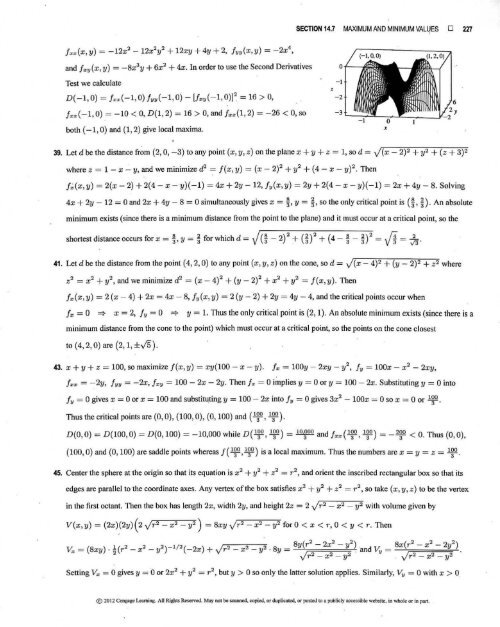Exercicios resolvidos James Stewart vol. 2 7ª ed - ingles
Create successful ePaper yourself
Turn your PDF publications into a flip-book with our unique Google optimized e-Paper software.
SECTION 14.7 MAXIMUM AND MINIMUM VAL4ES 0 227<br />
f :u:(x, y) = - 12x 2 -<br />
12x 2 y 2 + 12xy + 4y + 2, fvv(x, y) = - 2x",<br />
and f zv(x, y) = -8x 3 y + 6x 2 + 4x. In order to use the Second Derivatives<br />
Test we calculate<br />
- I<br />
Of-----1~<br />
D(-1,0) = fxx(-1, 0) / 7171 (-1,0) - [f:c 71 (- 1 , 0)] ~ = 16 > 0, -2<br />
/ :r:c ( - 1, 0) = -10 < 0, D (1, 2) = 16 > 0, and f:r:c{1, 2) = -26 < 0, so<br />
both ( -1, 0) and (1, 2) give local maxima.<br />
X<br />
39. Let d be the distance fr~m {2, 0, -3) to any point (x, y, z ) on the plane x + y + z = 1, sod= J(x - 2) 2 + y 2 + (z + 3)2<br />
where z = 1-x- y, and we minimize d 2 ~ f(x, y) = (x - 2) 2 + y 2 + {4 -<br />
x- y) 2 • Then<br />
j;,(x,y) = 2(x- 2) + 2{4- x - y)( -1) = 4x + 2y -12, f 71 (x,y) = 2y + 2(4 - x- y){-1) = 2x + 4y - 8. Solving<br />
4x + 2y- 12 = 0 and 2x + 4y- 8 = 0 simultaneously gives x = ~. y = ~.so the only critical point is(~,~). An absolute<br />
minimum exists (since there is a minimum di.stance from the point to the plane) and it must occur at a critical point, so the<br />
shortest distance occurs for x = ~. y = ~ for which d = J (~ - 2) 2 + (j) 2 + (4 - ~ - ~) 2 = ji = ~-<br />
41. Let d be the distance from the point {4, 2, 0) to any point {x, y, z) on the cone, sod = ,j(x - 4)2 + (y- 2)2 + z2 where<br />
z 2 = x 2 + y 2 , and we minimize d 2 = (x - 4) 2 + (y - 2) 2 + x 2 + y 2 = f(x, y). Then<br />
fz(x, y) = 2 (x - 4) + 2x = 4x - 8, f 71 (x, y) = 2 (y - 2) + 2y = 4y- 4, and the critical points occur when<br />
f., = 0 => x = 2, fu = 0 => y = 1. Thus the only critical point is (2, 1). An absolute minimum exists (since there is a<br />
minimum distance from the cone to the point) which must occur at a critical point, so the points on the cone closest<br />
to ( 4, 2, 0) are (2, 1, ±v'5).<br />
43. x + y + z = 100, so maximize f(x, y) = xy(l OO - x- y). f x = 100y- 2xy- y 2 , f 71 = 100x - x 2 - 2xy,<br />
f,:r. = - 2y, f vu = -2x, fxv = 100-2x- 2y. Then J,r; = 0 implies y = 0 or y = 100- 2x. Substituting y = 0 into<br />
fv = 0 gives x = 0 or x = 100 and substi~ting y = 100 - 2x into fv = 0 gives 3x 2 - 100x = 0 sox = 0 or 1 ~ .<br />
Thus the critical points are (0, 0), (100, 0), (0, 100) and ( 1 ~ 0 ,<br />
D(O, 0) = D{100, 0) = D {O, 100) = -10,000 while D(1~ 0 ,<br />
1 ~ 0 ) = 10·~ 00 and f xx (1~ 0 ,<br />
1 ~ 0 ) = - 2 ~ < 0. Thus (0, 0),<br />
(100, 0) and {0, 100) are saddle points whereas f( 1 ~ 0 ,<br />
1 ~ 0 ) is a local maximum. Thus the numbers are x = y = z = 1 ~ 0 .<br />
45. Center the sphere at the origin so that its equation is x 2 + y 2 + z 2 = 1·2 , and orient the inscrib<strong>ed</strong> rectangular box so that its<br />
<strong>ed</strong>ges are parallel to the coordinate axes. Any vertex of the box satisfies x 2 + y 2 + z 2 = r 2 , so take (x, y, z) to be the vertex<br />
1<br />
~ 0 ) .<br />
in the fi rst octant. Then the box has length 2x, width 2y, and height 2z = 2 ,jr 2 - x 2 -<br />
y 2 with <strong>vol</strong>ume given by<br />
V(x, y) = (2x)(2y)(2 Jr 2 - x 2 - y 2 ) = 8xy Jr 2 - x 2 - y 2 forO < x < r, 0 < y < r. Then<br />
8y(r 2 - 2x 2 - y 2 ) 8x(r 2 - x 2 - 2y 2 )<br />
,j r2 _ x2 _ y2<br />
. J r2 _ x2 _ y2<br />
V., = (Bxy) . ~(r2- x2- y2)-1f2( -2x) + ,jr2 - x2 - y2. By= . ·and Vv = .<br />
Setting Vx = 0 gives y = 0 or 2x 2 + y 2 = r 2 , but y > 0 so only the latter solution applies. Similarly, V 71 = 0 with x > 0<br />
© 201 2 Ccngoge lcruniny. All Rights Rcscn"Cd. May nol be scwliiCd. copi<strong>ed</strong>. or duplical<strong>ed</strong>. or post<strong>ed</strong> loa publicly accessible website, in \\bole or in pn.


